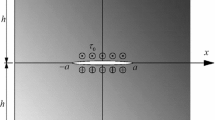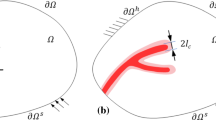Abstract
Mixed mode fracture in power law hardening materials near mode I loading conditions is investigated for the case of plane strain. It is demonstrated by application of full-field finite element analysis and two-parameter asymptotic analysis that the asymptotic mixed mode solution of Shih (1974), where the effects of arbitrary loading combine to enter the leading term of the asymptotic series, does not apply close to mode I. Instead, a `mode I dominant' higher order asymptotic form applies, where the leading term is the pure mode I symmetric HRR solution and the second term is antisymmetric. The significant difference between the two asymptotic solutions is the singular nature of the antisymmetric part of the stresses and strains. Therefore, near mode I the antisymmetric part of the local fields does not contribute to the J-integral. The transition from the mixed mode asymptotic solution to this two-term solution occurs when the ratio of the radial stress on the upper crack surface to that on the lower crack surface, i.e., σrr(r,+π)/σrr(r,−π), for the limit as r approaches zero, switches from −1 to +1. Budiansky and Rice (1973) predicted this change in sign somewhere between mode I and mode II. This sign change corresponds to the singular nature of the antisymmetric fields switching from the leading HRR eigenvalue to a weaker second term eigenvalue. Based on full-field finite element results, the far-field loading for which this `jump' occurs is very difficult to identify, as it originates deep within the plastic zone at unrealistically small distances from the crack tip. At the physical length scale on the order of the crack tip opening displacement, the transition from the mode II dominant asymptotic solution to the mode I dominant solution appears to be continuous, not abrupt. Identification of this transition is estimated from the full-field results by making use of the two asymptotic solutions. These results identify a breakdown in the HRR theory for the representation of the antisymmetric part of the stresses for mixed mode fracture near mode I. This breakdown is explained by the switching from a mixed mode solution to a higher order solution. Unfortunately, the practical application of this higher-order solution is limited to hardening powers of approximately 2<n<3.
Similar content being viewed by others
References
Betegon, C. and Hancock, J.W. (1991). Two-parameter characterization of elastic-plastic crack-tip fields. ASME Journal of Applied Mechanics 58, 104-110.
Budiansky, B. and Rice, J.R. (1973). Conservation laws and energy release rates. ASME Journal of Applied Mechanics 40, 201-203.
Chao, Y.J. and Zhu, X.K. (1998). J-A2 characterization of crack-tip fields: Extent of J-A2 dominance and size requirements. International Journal of Fracture 89, 285-307.
Dong, P. and Pan, J. (1990). Plane-strain mixed-mode near-tip fields in elastic perfectly plastic solids under smallscale yielding conditions. International Journal of Fracture 45, 243-262.
Donne, D. (1999). The crack tip displacement vector approach to mixed-mode fracture. Mixed-Mode Crack Behavior, ASTM STP 1359, 21-40.
Du, Z.Z., Betegon, C. and Hancock, J.W., (1991). J dominance in mixed mode loading. International Journal of Fracture 52, 191-206.
Hutchinson, J.W. (1968a). Singular behavior at the end of a tensile crack in a hardening material. Journal of the Mechanics and Physics of Solids 16, 13-31.
Hutchinson, J.W. (1968b). Plastic stress and strain fields at a crack tip. Journal of the Mechanics and Physics of Solids 16, 337-347.
Hutchinson, J.W. (1983). Fundamentals of the phenomenological theory of nonlinear fracture mechanics. ASME Journal of Applied Mechanics 50, 1042-1051.
Larsson, S.G. and Carlsson, A.J. (1973). Influence of non-singular stress terms and specimen geometry on smallscale yielding at crack tips in elastic-plastic material. Journal of the Mechanics and Physics of Solids 21, 263-278.
Laukkanen, A., Wallin, K. and Rintamaa, R. (1999). Evaluation of the effects of mixed mode I-II loading on elastic-plastic ductile fracture of metallic materials. Mixed-Mode Crack Behavior, ASTM STP 1359, 3-20.
Li, Y. and Wang, Z. (1986). High-order asymptotic field of tensile plane-strain nonlinear crack problems. Scientia Sinica 29, 941-955.
Loghin, A. and Joseph, P.F. (2001). Asymptotic solutions for mixed mode loading of cracks and wedges in power law hardening materials. Engineering Fracture Mechanics 68, 1511-1534.
Loghin, A., Zhang, N. and Joseph, P.F. (2000). A nonlinear finite element eigenanalysis of antiplane shear including higher order terms. Engineering Fracture Mechanics 66, 441-454.
McMeeking, R.M. and Parks, D.M. (1979). On Criteria for J-dominance of crack-tip fields in large scale yielding. Elastic-Plastic Fracture Mechanics, ASTM-STP 668, 175-194.
O'Dowd, N.P. and Shih, C.F. (1991). Family of crack-tip fields characterized by a triaxiality parameter - I. Structure of the fields. Journal of the Mechanics and Physics of Solids 39, 898-1015.
O'Dowd, N.P. and Shih, C.F. (1992). Family of crack-tip fields characterized by a triaxiality parameter - II. Fracture applications. Journal of the Mechanics and Physics of Solids 40, 939-963.
Pan, J. and Shih, C.F. (1992). Elastic-plastic analysis of combined mode I, II and III crack-tip fields under smallscale yielding conditions. International Journal of Solids and Structures 29, 2795-2814.
Rice, J.R. and Rosengren, G.F. (1968). Plane strain deformation near a crack tip in a power-law hardening material. Journal of the Mechanics and Physics of Solids 16, 1-12.
Rice, J.R. (1968). A path-independent integral and the approximate analysis of strain concentration by notches and cracks. ASME Journal of Applied Mechanics 35, 379-386.
Roy, Y.A. and Narasimhan, R. (1997). J-Dominance in mixed mode ductile fracture specimens, International Journal of Fracture 88, 259-279.
Sharma, S.M. and Aravas, N. (1991). Determination of higher-order terms in asymptotic elastoplastic crack tip solutions. Journal of the Mechanics and Physics of Solids 39, 1043-1072.
Sharma, S.M. and Aravas, N. (1993). On the development of variable-separable asymptotic elastoplastic solutions for interfacial cracks. International Journal of Solids and Structures 30, 695-723.
Shih, C.F. (1974). Small-scale yielding analysis of mixed-mode plane strain crack problems. Fracture Analysis, ASTM STP 560, 187-210.
Shih, C.F. and Asaro, R.J. (1989). Elastic-plastic analysis of cracks on bimaterial interfaces: Part II - Structure of small-scale yielding fields. ASME Journal of Applied Mechanics 56, 763-779.
Shih, C.F. and Asaro, R.J. (1990). Elastic-plastic and asymptotic fields of interface cracks. International Journal of Fracture 42, 101-116.
Symington, M., Shih, C.F., and Ortiz, M. (1988). A finite element method for determining the angular variation of asymptotic crack tip fields. Brown University Report MRG/DMR-8714665/1.
Symington, M., Ortiz, M. and Shih, C.F. (1990). A finite element method for determining the angular variation of asymptotic crack tip fields. International Journal of Fracture, 45, 51-64.
Xia, L. and Wang, T. (1993). Singular behavior near the tip of a sharp V-notch in a power law hardening material. International Journal of Fracture 59, 83-93.
Xia, I, Wang, T.C. and Shih, C.F. (1993). Higher-order analysis of crack tip fields in elastic power-law hardening materials. Journal of the Mechanics and Physics of Solids 41, 665-687.
Yang, S., Chao, Y.J. and Sutton, M.A. (1993a). Complete theoretical analysis for higher order asymptotic terms and the HRR zone at a crack tip for Mode I and Mode II loading of a hardening material. Acta Mechanica 98, 79-98.
Yang, S., Chao, Y.J. and Sutton, M.A. (1993b). Higher order asymptotic crack tip fields in a power-law hardening material. Engineering Fracture Mechanics 45, 1-20.
Zhang, N. and Joseph, P.F. (1998a). A nonlinear finite element eigenanalysis of singular plane stress fields in bimaterial wedges including complex eigenvalues. International Journal of Fracture 90, 175-207.
Zhang, N. and Joseph P.F. (1998b). A nonlinear finite element eigenanalysis of singular stress fields in bimaterial wedges for plane strain. International Journal of Fracture 94, 299-319.
Zhu, X.K. and Chao, Y.J. (2001). Constraint effects on crack-tip fields in elastic-perfectly plastic materials. Journal of the Mechanics and Physics of Solids 49, 363-399.
Author information
Authors and Affiliations
Corresponding author
Rights and permissions
About this article
Cite this article
Loghin, A., Joseph, P.F. Mixed mode fracture in power law hardening materials near Mode I. International Journal of Fracture 123, 81–106 (2003). https://doi.org/10.1023/B:FRAC.0000005796.82181.07
Issue Date:
DOI: https://doi.org/10.1023/B:FRAC.0000005796.82181.07




